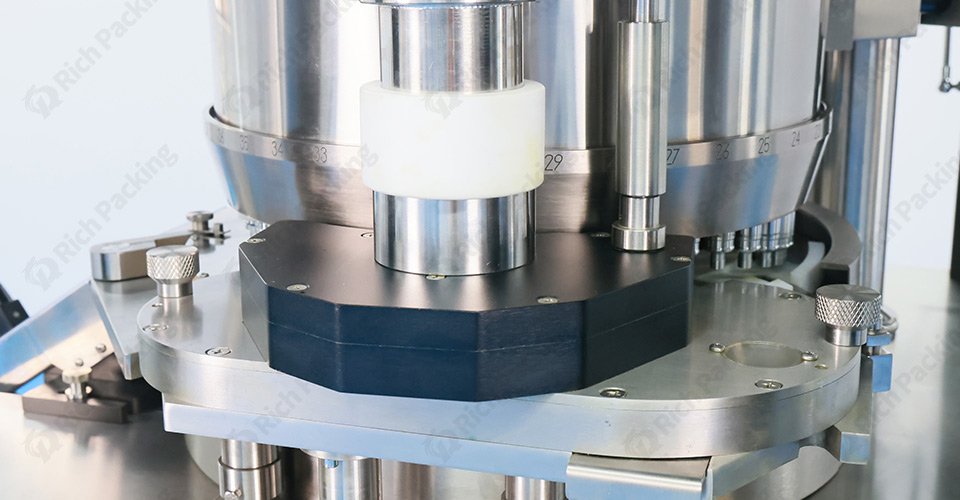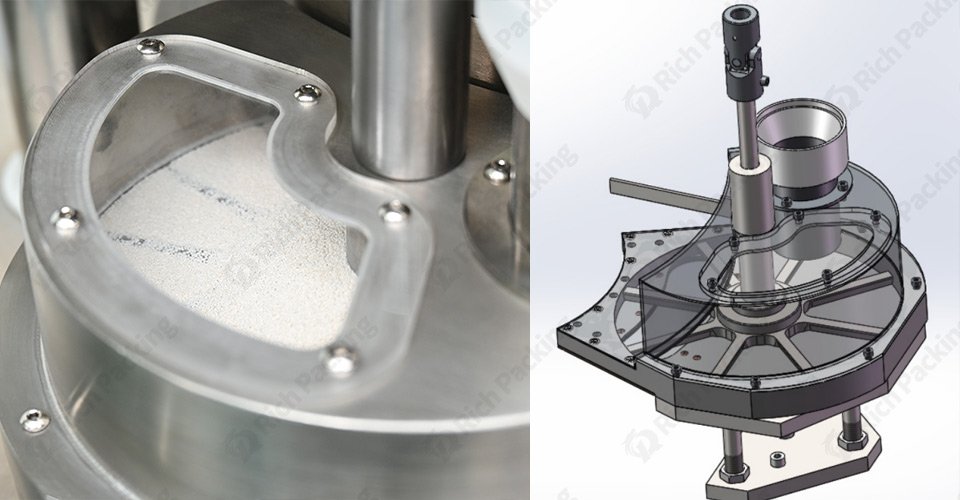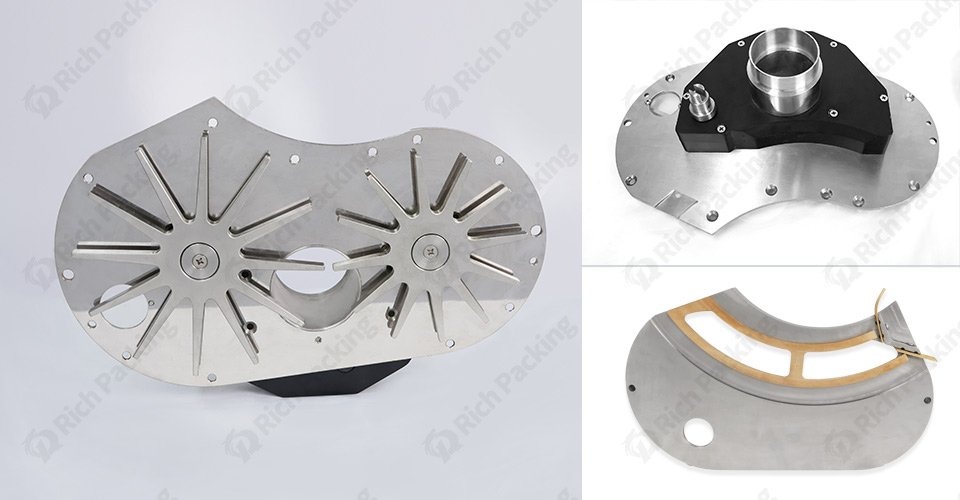Categories
New Blog
Tags
Many pharmaceutical and health care products in the production of solid tablets, is often encountered in the production of tablets, tablet weight, tablet thickness, hardness is not consistent, the down feeder clogging and other problems often need to stop the machine for maintenance resulting in low production efficiency as well as product quality can not be guaranteed. Most of these problems are caused by the uneven feeding of powder materials from the common discharger, then the forced feeder in the tablet press is the core component to solve the uneven feeding problem of the tablet press. Next, I will take you to deeply understand the working principle, structure and its advantages in the application of high speed tablet press.

Before understanding the forced feeder for tablet presses, we need to know what problems we will encounter in the production of the ordinary feeder for tablet presses?
Normal dosers rely on gravity to allow the material to fall naturally into the mold. If the material has poor fluidity (e.g., large or sticky particles), it is difficult to ensure that the material is evenly distributed into the mold each time the tablets are pressed, making it easy to underfill the mold. This leads to inconsistent tablet weight and affects the quality of the finished product.
Since the design of a common doser does not include a mechanical forcing device, for materials with poor fluidity, the filling process may produce “empty cavities” or “pile-up” phenomenon, resulting in inconsistent weight and density of each tablet. In pharmaceutical manufacturing, deviations in tablet weight often need to be controlled within a certain range, beyond which efficacy and compliance can be compromised.
The filling speed of a regular doser is limited by gravity, which means that on a high-speed tabletting line, material may not fill the mold as quickly, resulting in a restricted line tempo. As the tabletting speed increases, incomplete or uneven filling becomes more apparent, reducing productivity.
When handling certain powders or granular materials, clogging problems can occur with conventional dosers, especially if the material has a certain moisture or viscosity. In addition, the material may become stratified during the dosing process, with heavier particles being deposited below and lighter powders above, resulting in inconsistencies in tablet composition from batch to batch.
Normal dosers are best suited for well-flowing powders or granules, however, when it comes to poorly flowing materials (e.g., high humidity, irregular particles, or lighter materials), the material often does not fall smoothly by gravity. In this case, the doser will be frequently clogged or underfilled with material, resulting in poorly formed tablets.
Uneven filling not only affects the weight of tablets, but also the hardness and solubility of tablets. Tablets with insufficient hardness may crumble easily, while tablets with too much hardness may be difficult to dissolve, affecting the release rate and efficacy of the drug.
Due to the basic structure and working principle of ordinary dosers, it is difficult to realize precise control of materials in production. In large-scale pharmaceutical production, where high quality and consistency of tablets are required, it is easy to lead to unstable quality of tablets, and the output cannot keep up with the demand.
Although ordinary dosers occupy a certain market in small and medium-sized production due to their simplicity and low-cost advantages, they do not perform well in dealing with materials with poor fluidity, especially in large-scale production of pharmaceutical companies will encounter production speed and tablet consistency problems. Forced dosers are a good solution to these tablet production problems.
The Forced Dispenser is an important component of a high speed tablet press, designed to ensure uniform filling of the mold during tablet production to ensure consistent product quality and production efficiency. Unlike traditional gravity feeders, forced feeders use mechanical force to drive the material into the tablet mold, especially for poorly flowing or highly viscous powdered materials. The Forced Doser ensures consistent weight and density of each tablet in high speed tablet production, resulting in improved tablet production efficiency and quality and fewer defective products.
The core of the Forced Dispenser consists of several key components, including the mixing unit, the rotating impeller, and the feed channel. The various components work together through a mechanism that not only improves material flow, but also ensures uniform filling of the mold during each tablet pressing process, thus increasing overall production efficiency.
Understanding how a forced feeder works will help you better understand its importance in production. A forced feeder pushes material into the molds by mechanical force, ensuring uniform filling of each mold. The mixing device and the rotating impeller play a vital role in this process.
1. Stirring device: It is responsible for continuously stirring the material to avoid lumping or clogging of the powder in the feeding channel. Whether the materials are in powder or granular form, the stirring device ensures that they flow at a uniform speed and enter the rotating impeller smoothly.
2. Rotary impeller: precisely controls the speed and amount of material conveyed. It forcibly pushes the material from the feeding channel to the mold through mechanical force to ensure that the mold is evenly filled with material during each tablet pressing process, avoiding tablet quality problems caused by uneven material.

In order to further understand how a forced feeder works, let's analyze its components from a structural point of view:
Agitation system: The agitation system is located at the material inlet and its main function is to avoid agglomeration of the material before it enters the feeding channel. Continuous agitation ensures that the fluidity of the material is maintained in the desired state, preventing clogging or uneven flow.
Rotating Impeller: The rotation of the impeller pushes the material into the mold. This part of the assembly allows precise control of the amount of material fed into the mold, ensuring stable and consistent filling of the material at both high and low production speeds.
Feed Channel and Mold Interface: The material flows through the feed channel to the mold and ultimately into the mold. Precise control of this process ensures that each mold is filled with exactly the same amount of material, further enhancing the density and weight consistency of the tablets.
The close coordination of these components makes the forced feeder play a vital role in the entire tabletting process.

Choosing the right doser is critical in the tablet pressing process. And you may wonder, what exactly is the difference between a forced feeder and a regular feeder? Let's take a look at the following comparison table to get a clear picture of the differences:
|
Feature |
Forced Feeder |
Gravity Feeder |
|
Feeding Mechanism |
Mechanically driven to push materials forcefully |
Relies on gravity for natural material flow |
|
Material Suitability |
Suitable for materials with poor flow, such as sticky, wet, or irregular powders and granules |
Best for dry powders and granules with good flowability |
|
Production Speed |
Supports high-speed production with continuous and stable material supply |
Production speed is limited by material flowability, which may cause supply shortages at high speeds |
|
Tablet Consistency |
Enhances the consistency of tablet weight and composition, reducing variances in weight and thickness |
Lower consistency in tablet weight and composition, prone to variances in weight and thickness |
|
Cost |
Higher equipment and maintenance costs |
Lower equipment and maintenance costs |
|
Operational Difficulty |
Requires higher maintenance and operational skills |
Simple to operate and maintain |
|
Material Clogging |
Reduces occurrences of material clogging, ensuring continuous production |
Prone to material clogging, especially with wet or sticky materials |
The greatest advantage of the forced feeder is its ability to control the material, especially when handling poorly flowing or highly viscous materials. Therefore, high speed tablet presses equipped with a forced feeder are very suitable for the pharmaceutical industry, where large scale production of tablets is required to ensure consistent quality. The simple, low-cost, general purpose doser is more suitable for small to medium-sized production environments, especially for handling more fluid materials.
When choosing a tablet press, you need to give due consideration to matching the equipment to your production needs. While forced feeders excel in many scenarios, you still need to choose one based on the specific needs of your production line.
First and foremost, you need to ensure that the forced feeder you choose can meet the production needs of your business, especially with the demands of a high-speed production line. Equipment compatibility and expandability are also key factors, especially if you may expand your production line in the future, and choosing equipment with good expandability will avoid unnecessary duplication of investment.
By understanding the working principle and structure of a forced doser, you can better optimize your tablet compression production process. Whether it's improving tablet consistency or boosting productivity, a forced feeder can bring significant advantages to your production line. For more information on tablet presses you can contact us for more detailed information.